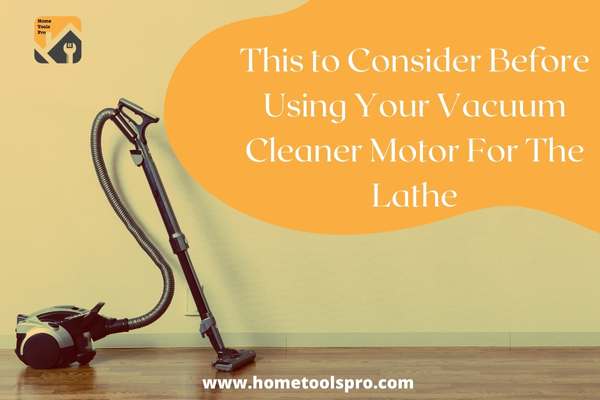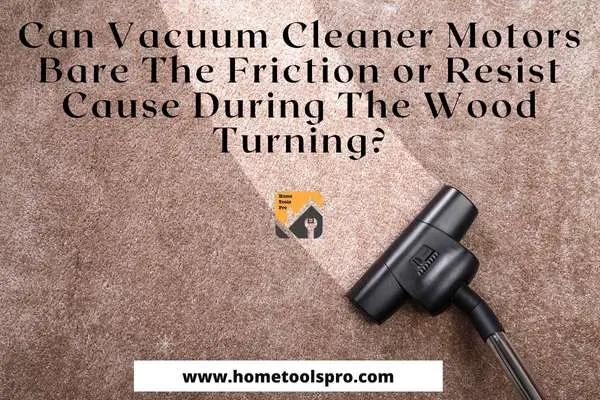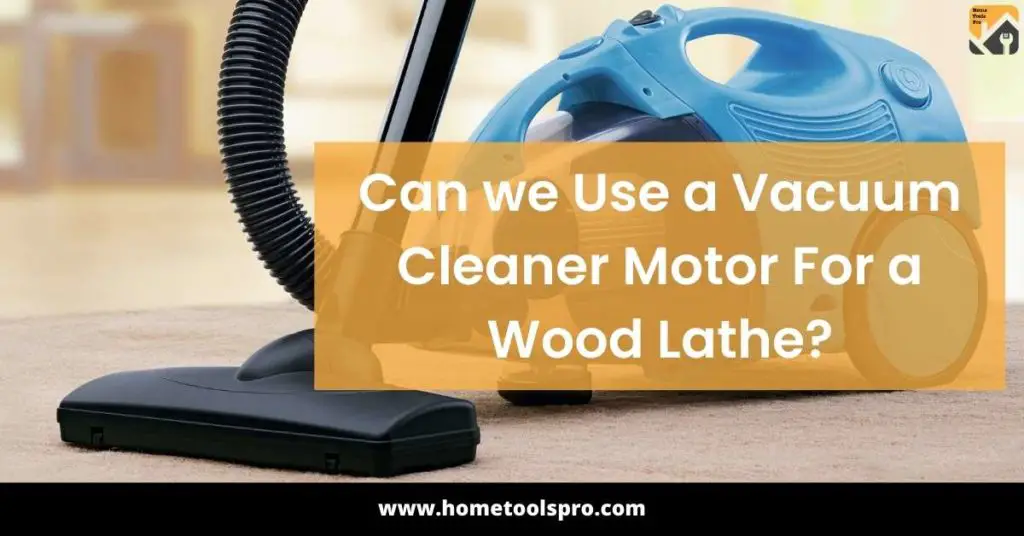Can we Really Use Vacuum Cleaner Motor For a Wood Lathe?
We often get asked whether it is possible to use a vacuum cleaner motor for a wood lathe.
The simple answer is yes, and you can use a vacuum cleaner motor for a wood lathe!
In fact, many people have done so with great success. However, you need to be aware of the potential dangers and take proper precautions.
This to Consider Before Using Your Vacuum Cleaner Motor For The Lathe

The biggest danger is that the vacuum cleaner motor is not designed for continuous use.
It will overheat if you run it over load for more than a few minutes at a time. This can damage the motor and potentially start a fire.
Another danger is that the vacuum cleaner motor is not designed to be run in reverse. If you try to use it for a wood lathe, the motor will probably overheat and burn out.
You need to take some basic safety precautions to use a vacuum cleaner motor for a wood lathe. First, make sure that the motor is properly ventilated.
Second, don’t run the motor for more than a few minutes at a time. And third, don’t try to use it in reverse.
With these precautions, you can safely use a vacuum cleaner motor for a wood lathe. Just be aware of the potential dangers, take the necessary precautions and be prepared with right tools.
How Powerful is a Vacuum Cleaner Motor?

A vacuum cleaner motor is responsible for generating the suction power that enables the vacuum the dust on carpets and floors.
The strength of the suction is determined by the power of the motor. A powerful motor will be able to generate more suction, making it more effective at cleaning.
There are two main types of vacuum cleaners motors: brushless and brushed. Brushed motors are the more traditional type of motor and tend to be less expensive.
Brushless motors are newer and more expensive but more efficient and durable.
In general, brushless motors are more powerful than brushed motors. However, some high-end vacuum cleaners come with very powerful brushed motors.
These vacuums are designed for professional use and can be quite expensive.
If you are looking for a powerful vacuum cleaner motor for a lathe conversion project, then you should consider choosing a brushless model.
Brushless motors are more efficient and durable, making them a good choice for most people.
What Are AC-Motors & DC-Motors?
There are two main types of electric motors: alternating current (AC) motors and direct current (DC) motors.
AC motors are the most common type of motor, and they’re used in a wide variety of applications, from fans and pumps to factory assembly lines.
DC motors are less common but still used in some applications, such as electric vehicles.
Both AC and DC motors work by using electromagnetism to create a force that turns the motor’s shaft.
In an AC motor, this force is created by alternating the direction of the current flowing through the motor’s coils.
In a DC motor, the current always flows in the same direction, so the force is created by reversing the direction of the current periodically.
AC motors are more efficient than DC motors and can operate at higher speeds.
However, they require more complex controller circuit, so DC motors are often used in applications where simplicity is important.
If you’re not sure which type of motor is right for your application, contact an engineer or electric motor specialist. They can help you choose the right motor for your needs.
Visual Explanations: https://www.youtube.com/watch?v=XplD4hAvXVY
How do You Determine The Power & Type of The Vacuum Cleaner Motor Required for Your Wood Lathe?

You need to think about a few factors when determining the power and type of vacuum cleaner motor required for your wood lathe.
The type of wood you’ll be using, the size of your lathe, and the speed at which you’ll be running the lathe all play a role in deciding which motor is best for your needs.
The wood you’ll use is probably the most important factor. Softer woods like pine and cedar will require less power than harder woods like oak and maple.
If you’re not sure how much power you need, it’s always better to err on the side of too much rather than too little.
The size of your lathe also plays a role in deciding which motor to use. A small lathe won’t need as much power as a large one.
And if you’re planning on running your lathe at high speeds, you’ll need a more powerful motor than if you’re only running it at lower speeds.
Finally, the speed at which you plan on running your lathe will also affect the power and type of motor you need.
If you’re only running your lathe at lower speeds, you won’t need as much power as if you’re running it at higher speeds.
But if you’re planning on running your lathe at high speeds, you’ll need a more powerful motor than if you’re only running it at lower speeds.
So, how do you determine the power and type of vacuum cleaner motor required for your wood lathe?
The answer depends on the type of wood you’ll be using, the size of your lathe, and the speed at which you’ll be running the lathe.
By considering all of these factors, you can ensure you get the right motor for your needs.
Can Vacuum Cleaner Motors Bare The Friction or Resist Cause During The Wood Turning?

The answer is yes, and they can. In fact, many people use this type vacuum clean motors to power their wood lathes.
The main reason why this works so well is that vacuum cleaner motors are designed to deal with high levels of friction.
The motors in vacuum cleaners are built to resistance wear and tear, meaning that they can handle the constant friction caused by woodturning without any problems.
Another advantage of using a vacuum cleaner motor for woodturning is that it produces a lot of torque.
This means that you can turn larger pieces of wood than you would be able to with a traditional electric motor.
If you’re looking for a powerful and durable motor for your wood lathe, then a vacuum cleaner motor is definitely worth considering for a easiest way to get better and smooth results.
Different Ways That You Can Mount a Vacuum Cleaner Motor to a Lathe

– Attach Using a Motor Pulley System:
You can use a motor pulley system to mount your vacuum cleaner motor to a lathe easily. This system uses a belt to connect the motor to the lathe, make something minimal to remove and replace the motor as needed.
– Attach Mount at Chuck:
You can also mount your vacuum cleaner motor directly onto the lathe chuck. This method is more secure, but removing the motor can be more difficult when you need to replace it.
Related Matters
What can you do with an old vacuum cleaner motor?
One interesting thing you can do with an old vacuum cleaner motor is use it as a powerful blower.
This can be useful for a number of applications, such as blowing leaves out of gutters or inflating inflatable objects.
You can also use the motor to power other devices, such as a small fan or electric wheelchair.
Additionally, if you are feeling creative, you could even use the motor to build your own miniaturized vacuum cleaner!
Are vacuum motors DC?
There are both AC and DC vacuum motors. Most modern vacuum cleaners use AC motors because they are more efficient.
However, DC vacuum motors have been coming back in recent years because they are smaller and lighter than AC motors. They are also easier to maintain because no commutator is worn out.
Does a vacuum use an electric motor?
A vacuum cleaner uses an electric motor to create a vacuum. The electric motor is used to spin a fan that draws in air.
The air is then sucked through a filter, and the dirt is trapped. The clean air is then expelled out of the machine.



